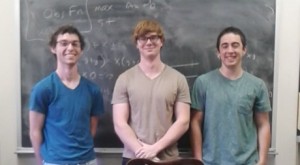
Clay Gardner, Mike Lis, and Tyler Perini recently participated in the 2014 COMAP (the Consortium for Mathematics and Its Applications) Mathematical Contest in Modeling. They formed one of several teams of students from the College of Charleston, and their solution of the contest problem earned them a “meritorius” rating reserved for the top 9% of contest entrants.
Clay, Mike, and Tyler were asked to share some thoughts on what it was like to work together and solve the problem.
Why did you participate in the COMAP MCM?
Mike had this to say:
I participated in COMAP because it sounded like the coolest math contest I have heard of. I think all three of us wanted to challenge ourselves to see what we were capable of producing in such a small time frame. I’ve always kind of glorified the archetype of the isolated mathematician and COMAP was a perfect opportunity to try it out.
Clay agreed that the experience sounded like fun:
I participated in COMAP mostly for fun, and because I was interested in working with Mike and Tyler. Also, I wanted to see how well we could preform when going against schools from around the world.
What was it like to work on this problem?
Clay responded with:
Working on a team made me realize how communication and getting along with each other is by far the most important aspect of creating good models and writing a paper. Having a breadth of skills is far much more important than a depth of skills, this goes for the individual as well as having three people with problem solving abilities that overlap as little as possible.
Mike added:
The time restriction definitely made the weekend interesting, I think we managed the clock very well. Working with Tyler and Clay was far and away the best part of the project. Bouncing ideas around was definitely fun, but it was also extremely insightful seeing how they approached the problem on their own.
Tyler, now a seasoned COMAP veteran, had this to add:
It’s always surprising how much fun COMAP is… I always go in nervous about the problem. After the first day, though, we got in the groove of working on the problem, and I loved hanging out with my team! There’s definitely some intense bonding over the weekend – hours of sweat, tears, frustration, and tons and tons of junk food will do that to you! You never get the true COMAP experience until you reach the stressful cramming of that last half hour before the paper is due, but we survived and learned a lot in the process!
On that note, the teammates were asked about what they learned throughout the process:
What did you learn (about math, modeling, new ideas and concepts, etc.) throughout the contest?
Clay:
I learned a lot about how to communicate, since we had two completely different models doing the same thing we had to make sure that we could effectively communicate our models back and forth to make sure that we still were solving the same problem.
Mike indicated how important it is to collaborate with others when working on a complicated problem:
Clay and Tyler are two of the most diligent people I’ve met. I learned a lot by working alongside them, seeing how much thought they each put into their work. I also learned the importance of communicating ideas well. We really made sure to understand why we were approaching the problem a certain way, to ensure that our ideas were worth the time investment of following through. I think if I had worked alone I would have wasted far more time chasing unfruitful ideas.
Overall, it was a great experience and a chance for the team to apply some of the abstract concepts they learn in their coursework. Next year’s teams will be challenged to do even better.


